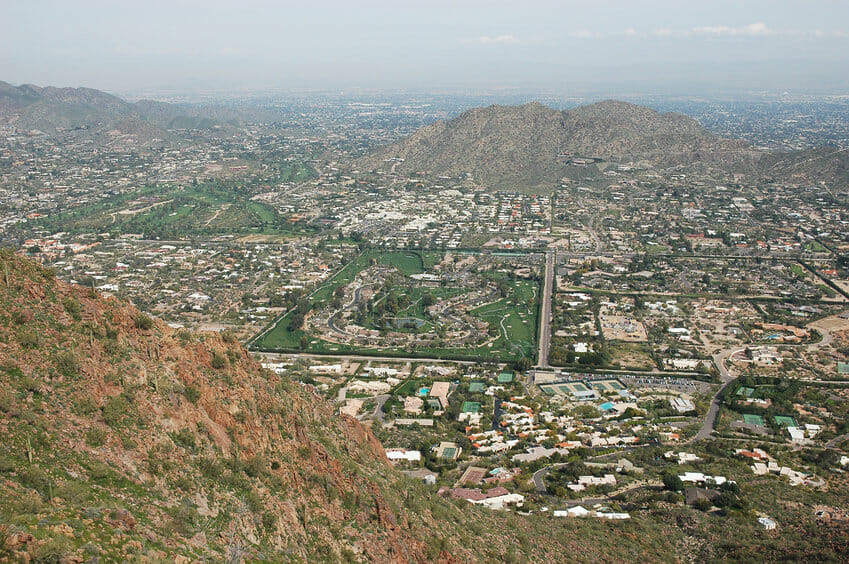The City of Phoenix will expand its research on cool pavement technology for local roads after phase one of “the largest installment in North America,” city officials said.
Phoenix officials unveiled a new city program named “Cool Corridors” to plant more shade trees into neighborhoods and along city streets where scientists want to establish a similar cooling effect.
This summer marked one year since the Street Transportation Department initiated a joint study with city officials and Arizona State University scientists to test how urban design can mitigate the effects of rising nighttime temperatures on land covered by asphalt and concrete, said Ryan Stevens, pavement manager engineer for the City of Phoenix.
An executive summary of ASU’s cool pavement pilot program can be found on the City of Phoenix website.
READ ALSO: ASU ranks No. 1 in Sierra Club’s ‘coolest schools’
As the fifth-most populated and one of the fastest growing cities in the country, development in Phoenix is spread out over nearly 5,000 miles of paved roads, said Kini Knudson, the director of Street Transportation for the City of Phoenix.
At a virtual presentation Tuesday, the City of Phoenix Street Transportation Department, in coordination with the City of Phoenix Office of Sustainability, ASU Global Institute of Sustainability and ASU Urban Climate Research Center, shared the results of scientific testing on cool pavement treatments spread throughout Phoenix in 2020 to evaluate next steps for the pilot program.

“Our vision is actually for Phoenix to be the most sustainable desert city on the planet,” said Mark Hartman, Chief Sustainability Officer for the City of Phoenix.
The total cost of Phoenix’s pilot program is about $3 million from the Arizona Highway Revenue Fund, which serves as the city’s street maintenance budget, Stevens said.
“What could one road do versus an entire neighborhood?” asked Jennifer Vanos, assistant professor at ASU’s School of Sustainability, in a video showcased at the event. “That’s what we have here.”
The program laid 36 miles of cool pavement, a non-toxic asphalt based sealcoat, in eight neighborhoods and a city park to increase the livability of urban materials in a desert climate and reduce oppressive weather conditions that contribute to incidences of heat-associated illness, explained Rubben Lolly, special projects administrator at the City of Phoenix Street Maintenance Division.
Since May, Maricopa County has recorded 123 heat-associated deaths with 172 cases still under investigation, according to a Sept. 4 heat surveillance report released by the Maricopa County Health Department.
Last summer, the city in the Sonoran Desert broke it’s all-time heat record, Lolly said.
According to the National Weather Service, Phoenix experienced 145 days of temperatures over 100 degrees Fahrenheit (37.7 Celsius) in 2020, the most in a calendar year. The previous record of 144 days occurred just a year earlier in 2019.
A team of eight ASU researchers collected data to measure the surface temperature, air temperature and mean radiant temperature using “a suite of different sensors” over roads coated with cool pavement, said Ariane Middel, the director of ASU’s Sensible Heatscapes and Digital Environment Lab.
Scientists conducted vehicle traverses on a strict schedule for 10 months in three of the eight neighborhoods for the air and surface temperature measurements, Middel said. In addition to heat stressors, they studied reflectivity, durability and skid resistance to cool pavement treatments.
Vanos displayed side-by-side images taken on helicopter overflights at 1 p.m. that used infrared thermography to contrast streets made of conventional asphalt from those where CoolSeal, a product of the project’s contracting partner Top Guard LLC, is applied.
The temperature difference between them read 11 degrees Fahrenheit.
Data collected at night that followed the same procedure resulted in smaller values due to “variability among the neighborhoods in terms of tree shade and vegetation,” and several additional factors, Vanos said.
“We can only learn so much in a one year study,” Stevens said.
In 2019, Middel traversed the streets of southern California with MaRTY, a biometerological cart, to gather information about thermal comfort.
Phoenix city officials first discovered the light grey, matte cool pavement product through a Federal Highway Administration workshop in Los Angeles, Stevens said.
LA covered around 50 city blocks in various reflective coatings and seals since 2015, according to a Climate Resolve presentation of the city’s findings.
Mayor Eric Garcetti announced a plan to cover 250 lane-miles of LA roads with cool pavement treatments by 2028. Other heat island mitigation strategies outlined in his administration’s Green New Deal include cool roofs, “urban greening,” and cooling centers throughout the city.
Sustainable alternatives to existing infrastructure have the potential to decrease the retention of heat within the urban environment, increase pavement life, and enhance safety for the people who live in “traditionally underserved areas” without much shade, said David Sailor, the director of ASU’s Urban Climate Research Center.
The Environmental Protection Agency reports normal pavement materials can eclipse 120 to 150 degrees Fahrenheit (48-67 Celsius) during peak summer, absorbing that sunlight rather than reflecting it back out into the city.
“This is one solution. It’s not the silver bullet,” Hartman said of cool pavements.
As part of outreach with ASU, the city surveyed community members in each neighborhood where cool pavement treatments are located this summer to solicit feedback, Stevens said. Researchers are currently reviewing the responses.
Researchers will wait on evaluation from the Phoenix City Council before launching phase two of the cool pavement pilot program.




